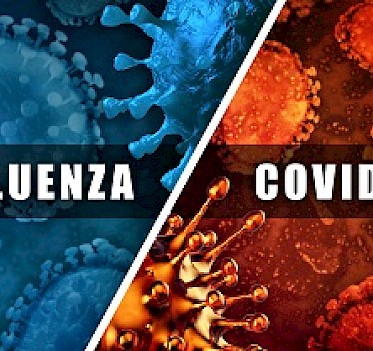What’s the Difference Between COVID-19 & The Flu?
At the end of 2019, a new virus started to spread and created a global pandemic that is still taking the world by storm. COVID-19 has been wreaking havoc on our world for over two years now, cycling through its series of peaks and valleys, and affecting everyone in different ways.
Flu season is not new by any means and having the flu is something most people have experienced for themselves. There is a good amount of debate, though, about the differences and similarities between the two: What has been considered a fairly “normal” virus to catch, and a disease that is breaking families and friends apart physically, emotionally, and even politically.
History
The first hit of the H1N1 Influenza pandemic came about in 1918, one year after the U.S. joined World War 1. Because of the lack of medical advances and the insane overcrowding in the barracks, hundreds of thousands of people fell ill and died. There were a few more waves over the next two years which created a shortage of nurses and medical staff, and an influx of soldiers going to war.
COVID-19 first came about at the end of 2019, but became very prominent during the first quarter of 2020. Since then, there have been multiple waves and variants, leaving hospitals and schools short-staffed and many graves filled too early.
Commonalities
How it Spreads
Viruses, as a whole, spread in similar ways – close proximity, respiratory droplets released through talking, sneezing, or coughing that can be inhaled or swallowed, or touching surfaces with the virus on it then touching their nose, eyes, or mouth. In this respect, COVID-19 and the Flu are no different.
Symptoms
A huge commonality between the COVID-19 virus and the influenza viruses is the symptoms. Both are centralized and start as a respiratory infection, so the overlap of this is not surprising:
- Fever
- Cough
- Shortness of breath
- Exhaustion
- Sore throat
- Runny/Stuffy Nose
- Muscle Aches
- Headache/Migraine
- Nausea (This is more common in children than adults)
The severity of these symptoms vary on the person, from extreme symptoms to asymptomatic. Testing is what can differentiate what is causing these reactions.
Complications
Considering that COVID-19 and the flu are usually centralized as an upper-respiratory issue, there are some pretty basic complications that can come from either of these viruses:
- Pneumonia
- Bronchitis
- Acute respiratory distress syndrome
- Organ failure
- Heart/brain inflammation
With every sickness or virus, there is always a possibility of death or permanent damage, and COVID-19 and the flu are no different. We’ve seen this as both pandemics rolled out.
Differences
Causes & Symptoms
As we prefaced earlier, symptoms are fairly similar between the flu and COVID-19, but how quickly you see them differs slightly. With COVID, the timeline to see the evidence of the virus is between two and fourteen days after exposure. The symptoms from the flu show up between one and four days after exposure.
COVID-19 also has additional symptoms that are usually seen a lot earlier than others, one of which is loss of taste and/or smell. The amount of time this lasts varies per person – some can taste and/or smell very shortly after they become healthy again, while some have still not recovered those senses after testing positive in early 2020.
Spread & Severity
The way the two viruses spread is the same, but what is actually being spread is different. “Flu” is short for “influenza,” which is the specific name of the two viruses under the “flu” umbrella: influenza A and B. COVID-19 is caused by a new coronavirus calles SARS-CoV-2. Different viruses mean different severity levels.
Although this is still being watched, COVID-19 seems to be more contagious than the flu. It also seems to be more deadly – 630,000 people had claimed COVID-19 as their cause of death in 2020 and 2021 in the U.S. alone, while only about 22,000 people died during the flu season of 2019 and 2020.
Treatments & Prevention
Symptoms of the flu have been proven to be treatable with easy-to-get, over-the-counter drugs. Treating the flu itself calls for a prescription from your urgent care doctor. For COVID-19, there has only been one antiviral drug that has consistently worked: Remdesivir. Researchers are evaluating many different treatments and drugs to help with the efforts, but have not come up with anything yet.
A few things to avoid spreading COVID-19:
- Avoid large events and groups of people
- Avoid close contact with anyone outside of your household
- Wash your hands often with soap and water, and be aware of what you are touching around you
- Cover your mouth and nose when coughing or sneezing
- Clean and disinfect high-touch surfaces
Healthcare Express
This time in our world is a bit topsy-turvy, but also repetitive of our history. Thankfully, we have technological and medical advances that allow us to take care of ourselves in the best way possible! At Healthcare Express, we take care of our people – COVID-19, the flu, and anything other health factors you might be concerned about, we’ll assess and treat. Visit our urgent care near you the next time you need non-emergency medical care.
